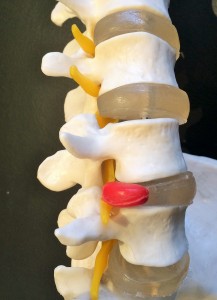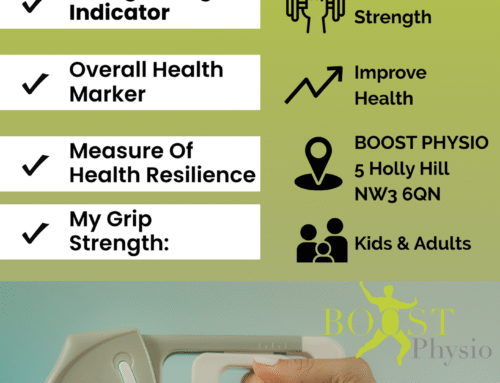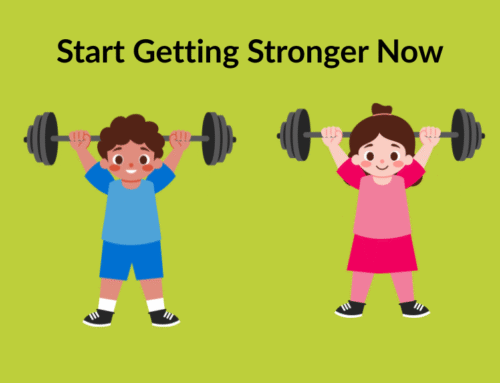The above scan belongs to a 29 year old woman who presented with new-onset pain and tingling in her right leg. The patient had a steroid injection, as well as a course of physiotherapy including soft tissue work, stretches and core strengthening. Within five months, her disc herniation had resolved, the pain and paraesthesia had completely gone. (Hong, J & Ball, P (2016) N Engl J Med 2016; 374:1564)
Figure A: MRI at the time of injury; the yellow arrow shows a lumbar disc herniation and nerve root compression.
Figure B: MRI at 5 months post-injury; the green arrow shows the disc is no longer compressing the nerve or spinal cord (white/grey column next to the vertebrae), with complete resolution of the slipped disc.
BOOST PHYSIO’s Treatment Approach to Disc Injuries
What is a “slipped disc” / herniated disc / bulging disc?
The spine is made up of 24 vertebrae that are stacked on top of each other. Between each vertebra, there is a disc made of a soft gel-like material, which acts as a shock-absorber or cushion. Discs are vital to help your back maintain its flexibility and range of movement. A slipped disc is a very common cause of back pain, and although the name can sound quite dramatic , it can be reassuring to note that the disc doesn’t actually ‘slip’.

The red area shows the leaked disc fluid pressing on the spinal nerve (yellow), which can become inflamed, causing back pain and symptoms down the leg.
The outer-shell of the disc becomes damaged, so the gel inside protrudes causing the disc to bulge. Disc herniation, bulging or “slipping” are often used interchangeably (although medically can be somewhat different).
The lumbar discs lie directly adjacent to the spinal nerve root, therefore the bulging disc or leaked disc fluid can put pressure directly onto the nerve, causing back pain and radiating pain down the leg. When the nerve is compressed or irritated, the symptoms can spread down your legs causing numbness, tingling or weakness, called a radiculopathy. In many people, the sciatic nerve is affected, resulting in sciatica or neural symptoms down the leg. A slipped, herniated and bulged disc all essentially refer to the same type of injury. The variation in name can indicate how much of the disc fluid has leaked out, and whether or not it is compressing the nerve.
What causes a slipped disc?
With age, the discs lose some of their water content, making the disc less effective as a cushion, and more susceptible to injury following minimal strain or effort. Sometimes twisting or turning whilst lifting heavy objects can lead to a slipped disc, and people often don’t realise the extent of the injury at the time. The disc can put pressure on either the whole spinal cord or just a single nerve root. This means that you can have pain in the back where the herniation occurred, or other areas of the body that the affected nerve controls, for example the buttocks or feet.
How does BOOST PHYSIO treat disc injuries?
Our Specialist Treatment Approach
At BOOST PHYSIO, we take a holistic and personalised approach to treating lumbar disc problems. We start with a thorough assessment and then tailor a treatment plan that may include:
1. Patient Education and Advice
- Clear explanation of your diagnosis and how disc problems affect movement and pain
- Guidance on activity modification, ergonomics, and posture
- Strategies to reduce flare-ups and build confidence in movement
2. Manual Therapy
- Hands on treatments to ease pain, muscle spasm and restore mobility to the spine.
- Spinal mobilisation techniques to improve joint mobility.
- Soft tissue massage to reduce muscle spasm and tension in the lower back.
- Passive stretching to release muscle tension and improve flexibility.
3. Exercise Rehabilitation
- Targeted exercises to strengthen core stabilising muscles.
- Flexibility and mobility exercises to improve spinal movement.
- Progressive rehabilitation to build spinal control and function.
4. Acupuncture / Dry Needling
- Used to relieve deep muscle tension and reduce referred nerve pain.
- Often helpful in cases with associated sciatica.
5. Nerve Tissue Mobilisation
- Techniques to gentle move the nerves being irritated or compressed.
- This is a combination of hands on treatment and patient homework.
6. Postural Correction and Movement Retraining
- Helping you re-learn safe ways to bend, sit, lift, and walk
- Reducing pressure on the disc and surrounding nerves
7. Taping
- Temporary support and pain relief to the back muscles and joints.
- Helps with movement correction, preventing excessive bending of the spine when this is an aggravating movement.

Why BOOST PHYSIO?
✅ We guarantee your best recovery!
✅ Over 1,047x ⭐️⭐️⭐️⭐️⭐️ Patient Google reviews.
✅ Senior expert physiotherapists with spinal rehab experience.
✅ Evidence-based, hands-on treatment and rehab.
✅ Personalised plans to help you return to work, sport, and life.
✅ 9 convenient London locations across London & Hertfordshire.
✅ Trusted by spinal surgeons and GPs.








